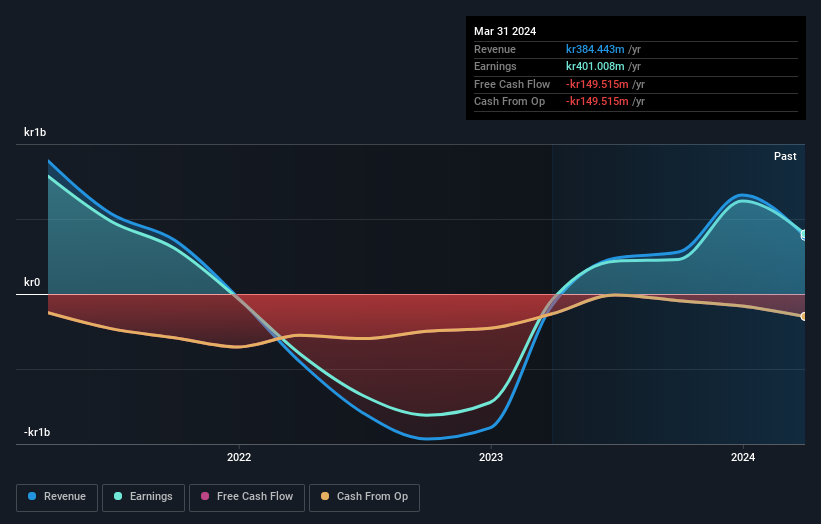- Sweden
- /
- Capital Markets
- /
- OM:LINC
Linc AB's (STO:LINC) market cap increased by kr492m, insiders receive a 64% cut

Key Insights
- Linc's significant insider ownership suggests inherent interests in company's expansion
- 57% of the company is held by a single shareholder (Bengt Julander)
- Institutions own 25% of Linc
Every investor in Linc AB (STO:LINC) should be aware of the most powerful shareholder groups. And the group that holds the biggest piece of the pie are individual insiders with 64% ownership. That is, the group stands to benefit the most if the stock rises (or lose the most if there is a downturn).
As a result, insiders scored the highest last week as the company hit kr5.2b market cap following a 10% gain in the stock.
Let's delve deeper into each type of owner of Linc, beginning with the chart below.
View our latest analysis for Linc

What Does The Institutional Ownership Tell Us About Linc?
Institutions typically measure themselves against a benchmark when reporting to their own investors, so they often become more enthusiastic about a stock once it's included in a major index. We would expect most companies to have some institutions on the register, especially if they are growing.
Linc already has institutions on the share registry. Indeed, they own a respectable stake in the company. This can indicate that the company has a certain degree of credibility in the investment community. However, it is best to be wary of relying on the supposed validation that comes with institutional investors. They too, get it wrong sometimes. If multiple institutions change their view on a stock at the same time, you could see the share price drop fast. It's therefore worth looking at Linc's earnings history below. Of course, the future is what really matters.

Linc is not owned by hedge funds. Bengt Julander is currently the largest shareholder, with 57% of shares outstanding. With such a huge stake in the ownership, we infer that they have significant control of the future of the company. With 5.0% and 4.0% of the shares outstanding respectively, Nordea Investment Management, AB and Swedbank Robur Fonder AB are the second and third largest shareholders. Additionally, the company's CEO Karl Tobieson directly holds 3.5% of the total shares outstanding.
Researching institutional ownership is a good way to gauge and filter a stock's expected performance. The same can be achieved by studying analyst sentiments. Our information suggests that there isn't any analyst coverage of the stock, so it is probably little known.
Insider Ownership Of Linc
While the precise definition of an insider can be subjective, almost everyone considers board members to be insiders. The company management answer to the board and the latter should represent the interests of shareholders. Notably, sometimes top-level managers are on the board themselves.
I generally consider insider ownership to be a good thing. However, on some occasions it makes it more difficult for other shareholders to hold the board accountable for decisions.
Our most recent data indicates that insiders own the majority of Linc AB. This means they can collectively make decisions for the company. So they have a kr3.3b stake in this kr5.2b business. It is good to see this level of investment. You can check here to see if those insiders have been buying recently.
General Public Ownership
The general public, who are usually individual investors, hold a 11% stake in Linc. This size of ownership, while considerable, may not be enough to change company policy if the decision is not in sync with other large shareholders.
Next Steps:
It's always worth thinking about the different groups who own shares in a company. But to understand Linc better, we need to consider many other factors. Take risks for example - Linc has 1 warning sign we think you should be aware of.
Of course this may not be the best stock to buy. So take a peek at this free free list of interesting companies.
NB: Figures in this article are calculated using data from the last twelve months, which refer to the 12-month period ending on the last date of the month the financial statement is dated. This may not be consistent with full year annual report figures.
If you're looking to trade Linc, open an account with the lowest-cost platform trusted by professionals, Interactive Brokers.
With clients in over 200 countries and territories, and access to 160 markets, IBKR lets you trade stocks, options, futures, forex, bonds and funds from a single integrated account.
Enjoy no hidden fees, no account minimums, and FX conversion rates as low as 0.03%, far better than what most brokers offer.
Sponsored ContentNew: AI Stock Screener & Alerts
Our new AI Stock Screener scans the market every day to uncover opportunities.
• Dividend Powerhouses (3%+ Yield)
• Undervalued Small Caps with Insider Buying
• High growth Tech and AI Companies
Or build your own from over 50 metrics.
Have feedback on this article? Concerned about the content? Get in touch with us directly. Alternatively, email editorial-team (at) simplywallst.com.
This article by Simply Wall St is general in nature. We provide commentary based on historical data and analyst forecasts only using an unbiased methodology and our articles are not intended to be financial advice. It does not constitute a recommendation to buy or sell any stock, and does not take account of your objectives, or your financial situation. We aim to bring you long-term focused analysis driven by fundamental data. Note that our analysis may not factor in the latest price-sensitive company announcements or qualitative material. Simply Wall St has no position in any stocks mentioned.
About OM:LINC
Linc
A private equity and venture capital firm, specializing in early and mature stage investments in pharmaceutical, life-science and med-tech companies.
Flawless balance sheet with acceptable track record.
Market Insights
Community Narratives




